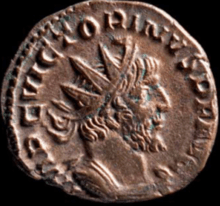Victorinus
| Victorinus | |||||
|---|---|---|---|---|---|
| Emperor of the Gallic Empire | |||||
.jpg) Ancient coin featuring Victorinus. | |||||
| Reign | 268–270[1] or 269–271[2] | ||||
| Predecessor | Marcus Aurelius Marius | ||||
| Successor | Victoria / Domitianus II / Tetricus I | ||||
| Born | Gaul | ||||
| Died |
270 or early 271 Colonia Claudia Ara Agrippinensium | ||||
| Issue | Victorinus Junior | ||||
| |||||
| Mother | Victoria | ||||
Marcus Piavonius Victorinus[note 1] was emperor in the Gallic provinces from 268 to 270[1] or 269 to 271,[2] following the brief reign of Marius. He was murdered by a jealous husband whose wife he tried to seduce.
Reign
Hailing from Gaul,[3] Victorinus was born to a family of great wealth,[2] and was a soldier under Postumus, the first of the so-called Gallic emperors.[1] He showed considerable ability, as he held the title of tribunus praetorianorum (tribune of the praetorians) in 266/267,[1][2][4] and rose swiftly to become co-consul with Postumus in 268.[5][4] It is also possible that Postumus then elevated him to the post of praetorian prefect.[6]
After engineering the death of Marius, Victorinus was declared emperor by the troops located at Augusta Treverorum in the fall of 269.[6][7] His principal concern was to prevent the western provinces from submitting to the central authority of the Roman Empire, a fact made clear to him from the first few weeks when only the provinces of Gaul, Germania and Britain recognised him. Hispania deserted the Gallic Empire and declared its loyalty to Claudius Gothicus.[6][2] Claudius then sent his trusted general Placidianus to south-east Gaul with instructions to bring over as many of the wavering cities as he could.[5] Very quickly Placidianus captured Cularo (ancient Grenoble), but did not proceed any further.[6]
The presence of Placidianus inspired the city of Augustodunum Haeduorum to abandon Victorinus and declare its intention to declare for Claudius Gothicus.[5][6] This forced Victorinus to march south and besiege it, where it fell after seven months, after which Victorinus’ troops plundered and destroyed the city.[5][2][4] Victorinus returned to Colonia Claudia Ara Agrippinensium in triumph.[2] It remains a mystery just why Claudius did not authorise Placidianus to go to the relief of Augustodunum Haeduorum; however, it is speculated that Claudius, who was fully engaged either in Italy against the Alamanni or in the Balkans against the Goths, did not wish to open a second theatre of operations in Gaul, which would not only have involved a major military effort, but would also have required Claudius to assume responsibility for the defense of the Rhine frontier had he been successful.[8] There is evidence to suggest that Claudius was having some difficulties in the East, which also occupied his attention.[6]
Victorinus was murdered at Colonia Claudia Ara Agrippinensium[1] in early 271[9] by Attitianus, one of his officers, whose wife Victorinus had supposedly seduced.[10][4] Since the motive was personal and not political,[2][10] Victorinus' mother, Victoria (or Vitruvia), was able to continue to hold power after the death of Victorinus and she arranged for his deification and, after considerable payment to the troops, the appointment of Tetricus I as his successor.[10][2] Another military commander appears to have been proclaimed as the emperor Domitianus II, but was soon eliminated.[11]
Victorinus is listed among the Thirty Tyrants in the Historia Augusta. The (dubious) Historia Augusta equally has a short description of Victorinus Junior, allegedly the son of Victorinus, who was appointed emperor by his family the day his father was murdered, and would have been killed immediately afterwards by the troops. The Historia Augusta also says that both father and son were buried near Colonia Claudia Ara Agrippinensium in marble tombs.[12]

Notes
- ↑ Some of the inscriptions record his name as M. Piavvonius Victorinus, as does the first release of coins from the Colonia mint. A mosaic from Augusta Treverorum (Trier) lists him as Piaonius.
References
- 1 2 3 4 5 Martindale, p. 965
- 1 2 3 4 5 6 7 8 9 Polfer, Victorinus
- ↑ Potter, p. 261
- 1 2 3 4 Canduci, p. 92
- 1 2 3 4 Southern, p. 118
- 1 2 3 4 5 6 Potter, p. 266
- ↑ Canduci, p. 91
- ↑ Watson, Alaric (1999). Aurelian and the Third Century. London: Routledge. p. 90.
- ↑ Potter, p. 272
- 1 2 3 Southern, p. 119
- ↑ Canduci, p. 96
- ↑ Historia Augusta, Tyranni Triginta, 7:1
Sources
Primary sources
- Aurelius Victor, Epitome de Caesaribus
- Aurelius Victor, Liber de Caesaribus
- Eutropius, Brevarium, Book 9
- Historia Augusta, The Thirty Tyrants
Secondary sources
- Southern, Pat (2001). The Roman Empire from Severus to Constantine. Routledge.
- Potter, David Stone (2004). The Roman Empire at Bay, AD 180-395. Routledge.
- Jones, A.H.M.; Martindale, J.R. (1971). The Prosopography of the Later Roman Empire, Vol. I: AD260-395. Cambridge University Press.
- Canduci, Alexander (2010). Triumph & Tragedy: The Rise and Fall of Rome's Immortal Emperors. Pier 9. ISBN 978-1-74196-598-8.
- Polfer, Michel (1999). "Victorinus (A.D. 269-271)". De Imperatoribus Romanis.
- J. F. Drinkwater, The Gallic Empire: Separatism and Continuity in the North-western Provinces of the Roman Empire A.D. 260–274 (Stuttgart 1987)
External links
 Media related to Victorinus at Wikimedia Commons
Media related to Victorinus at Wikimedia Commons
| Regnal titles | ||
|---|---|---|
| Preceded by Marcus Aurelius Marius |
Emperor of the Gallic Empire 269-271 |
Succeeded by Domitianus and/or Tetricus I |
| Political offices | ||
| Preceded by Gallienus, Sabinillus |
Consul of the Roman Empire 268 with Postumus , Ovinius Paternus, Arcesilaus |
Succeeded by Aspasius Paternus, Publius Licinius Egnatius Marinianus, Postumus |
| Preceded by Aspasius Paternus, Publius Licinius Egnatius Marinianus , Postumus |
Consul of the Roman Empire 269-270 with Sanctus , Claudius II, Paternus |
Succeeded by Aurelian, Pomponius Bassus , Tetricus I |